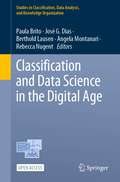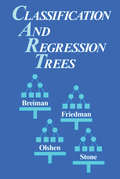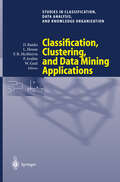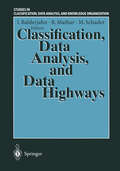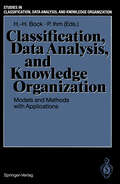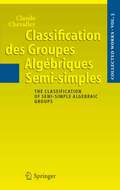- Table View
- List View
Classification and Data Analysis: Theory and Application Proceedings of the Biannual Meeting of the Classification Group of Società Italiana di Statistica (SIS) Pescara, July 3–4, 1997 (Studies in Classification, Data Analysis, and Knowledge Organization)
by Maurizio Vichi Otto OpitzInternational Federation of Classification Societies The International Federation of Classification Societies (IFCS) is an agency for the dissemination of technical and scientific information concerning classification and data analysis in the broad sense and in as wide a· range of applications as possible; founded in 1985 in Cambridge (UK) from the following Scientific Societies and Groups: British Classification Society -BCS; Classification Society of North America -CSNA; Gesellschaft fUr Klassifikation -GfKl; Japanese Classification Society -JCS; Classification Group of Italian Statistical Society - COSIS; Societe Francophone de Classification -SFC. Now the IFCS includes the following Societies: Dutch-Belgian Classification Society - VOC; Polish Classification Section - SKAD; Portuguese Classification Association - CLAD; Group-at-Large; Korean Classification Society -KCS. Biannual Meeting of the Classification and Data Analysis Group of SIS The biannual meeting of the Classification and Data Analysis Group of Societa Italiana di Statistica (SIS) was held in Pescara, July 3 -4, 1997. The 69 papers presented were divided in 17 sessions. Each session was organized by a chairperson with two invited speakers and two contributed papers from a call for papers. All the works were referred. Furthermore, during the meeting a discussant was provided for each session. A short version of the papers (4 pages) was.published before the conference.
Classification and Data Mining (Studies in Classification, Data Analysis, and Knowledge Organization)
by Antonio Giusti, Gunter Ritter and Maurizio VichiThis volume contains both methodological papers showing new original methods, and papers on applications illustrating how new domain-specific knowledge can be made available from data by clever use of data analysis methods. The volume is subdivided in three parts: Classification and Data Analysis; Data Mining; and Applications. The selection of peer reviewed papers had been presented at a meeting of classification societies held in Florence, Italy, in the area of "Classification and Data Mining".
Classification and Data Science in the Digital Age (Studies in Classification, Data Analysis, and Knowledge Organization)
The contributions gathered in this open access book focus on modern methods for data science and classification and present a series of real-world applications. Numerous research topics are covered, ranging from statistical inference and modeling to clustering and dimension reduction, from functional data analysis to time series analysis, and network analysis. The applications reflect new analyses in a variety of fields, including medicine, marketing, genetics, engineering, and education.The book comprises selected and peer-reviewed papers presented at the 17th Conference of the International Federation of Classification Societies (IFCS 2022), held in Porto, Portugal, July 19–23, 2022. The IFCS federates the classification societies and the IFCS biennial conference brings together researchers and stakeholders in the areas of Data Science, Classification, and Machine Learning. It provides a forum for presenting high-quality theoretical and applied works, and promoting and fostering interdisciplinary research and international cooperation. The intended audience is researchers and practitioners who seek the latest developments and applications in the field of data science and classification.
Classification and Dissimilarity Analysis (Lecture Notes in Statistics #93)
by Bernard Van CutsemClassifying objects according to their likeness seems to have been a step in the human process of acquiring knowledge, and it is certainly a basic part of many of the sciences. Historically, the scientific process has involved classification and organization particularly in sciences such as botany, geology, astronomy, and linguistics. In a modern context, we may view classification as deriving a hierarchical clustering of objects. Thus, classification is close to factorial analysis methods and to multi-dimensional scaling methods. It provides a mathematical underpinning to the analysis of dissimilarities between objects.
Classification and Examples of Differential Equations and their Applications (Mathematics and Physics for Science and Technology)
by Luis Manuel Braga da Costa CamposClassification and Examples of Differential Equations and their Applications is the sixth book within Ordinary Differential Equations with Applications to Trajectories and Vibrations, Six-volume Set. As a set, they are the fourth volume in the series Mathematics and Physics Applied to Science and Technology. This sixth book consists of one chapter (chapter 10 of the set). It contains 20 examples related to the preceding five books and chapters 1 to 9 of the set. It includes two recollections: the first with a classification of differential equations into 500 standards and the second with a list of 500 applications. The ordinary differential equations are classified in 500 standards concerning methods of solution and related properties, including: (i) linear differential equations with constant or homogeneous coefficients and finite difference equations; (ii) linear and non-linear single differential equations and simultaneous systems; (iii) existence, unicity and other properties; (iv) derivation of general, particular, special, analytic, regular, irregular, and normal integrals; (v) linear differential equations with variable coefficients including known and new special functions. The theory of differential equations is applied to the detailed solution of 500 physical and engineering problems including: (i) one- and multidimensional oscillators, with damping or amplification, with non-resonant or resonant forcing; (ii) single, non-linear, and parametric resonance; (iii) bifurcations and chaotic dynamical systems; (iv) longitudinal and transversal deformations and buckling of bars, beams, and plates; (v) trajectories of particles; (vi) oscillations and waves in non-uniform media, ducts, and wave guides. Provides detailed solution of examples of differential equations of the types covered in tomes l-5 of the set (Ordinary Differential Equations with Applications to Trajectories and Vibrations, Six -volume Set) Includes physical and engineering problems that extend those presented in the tomes 1-6 (Ordinary Differential Equations with Applications to Trajectories and Vibrations, Six-volume Set) Includes a classification of ordinary differential equations and their properties into 500 standards that can serve as a look-up table of methods of solution Covers a recollection of 500 physical and engineering problems and sub-cases that involve the solution of differential equations Presents the problems used as examples including formulation, solution, and interpretation of results
Classification and Examples of Differential Equations and their Applications (Mathematics and Physics for Science and Technology)
by Luis Manuel Braga da Costa CamposClassification and Examples of Differential Equations and their Applications is the sixth book within Ordinary Differential Equations with Applications to Trajectories and Vibrations, Six-volume Set. As a set, they are the fourth volume in the series Mathematics and Physics Applied to Science and Technology. This sixth book consists of one chapter (chapter 10 of the set). It contains 20 examples related to the preceding five books and chapters 1 to 9 of the set. It includes two recollections: the first with a classification of differential equations into 500 standards and the second with a list of 500 applications. The ordinary differential equations are classified in 500 standards concerning methods of solution and related properties, including: (i) linear differential equations with constant or homogeneous coefficients and finite difference equations; (ii) linear and non-linear single differential equations and simultaneous systems; (iii) existence, unicity and other properties; (iv) derivation of general, particular, special, analytic, regular, irregular, and normal integrals; (v) linear differential equations with variable coefficients including known and new special functions. The theory of differential equations is applied to the detailed solution of 500 physical and engineering problems including: (i) one- and multidimensional oscillators, with damping or amplification, with non-resonant or resonant forcing; (ii) single, non-linear, and parametric resonance; (iii) bifurcations and chaotic dynamical systems; (iv) longitudinal and transversal deformations and buckling of bars, beams, and plates; (v) trajectories of particles; (vi) oscillations and waves in non-uniform media, ducts, and wave guides. Provides detailed solution of examples of differential equations of the types covered in tomes l-5 of the set (Ordinary Differential Equations with Applications to Trajectories and Vibrations, Six -volume Set) Includes physical and engineering problems that extend those presented in the tomes 1-6 (Ordinary Differential Equations with Applications to Trajectories and Vibrations, Six-volume Set) Includes a classification of ordinary differential equations and their properties into 500 standards that can serve as a look-up table of methods of solution Covers a recollection of 500 physical and engineering problems and sub-cases that involve the solution of differential equations Presents the problems used as examples including formulation, solution, and interpretation of results
Classification and Information Processing at the Turn of the Millennium: Proceedings of the 23rd Annual Conference of the Gesellschaft für Klassifikation e.V., University of Bielefeld, March 10–12, 1999 (Studies in Classification, Data Analysis, and Knowledge Organization)
by Reinhold Decker Wolfgang A. GaulThis volume contains revised versions of selected papers presented dur ing the 23rd Annual Conference of the German Classification Society GfKl (Gesellschaft fiir Klassifikation). The conference took place at the Univer sity of Bielefeld (Germany) in March 1999 under the title "Classification and Information Processing at the Turn of the Millennium". Researchers and practitioners - interested in data analysis, classification, and information processing in the broad sense, including computer science, multimedia, WWW, knowledge discovery, and data mining as well as spe cial application areas such as (in alphabetical order) biology, finance, genome analysis, marketing, medicine, public health, and text analysis - had the op portunity to discuss recent developments and to establish cross-disciplinary cooperation in their fields of interest. Additionally, software and book pre sentations as well as several tutorial courses were organized. The scientific program of the conference included 18 plenary or semi plenary lectures and more than 100 presentations in special sections. The peer-reviewed papers are presented in 5 chapters as follows: • Data Analysis and Classification • Computer Science, Computational Statistics, and Data Mining • Management Science, Marketing, and Finance • Biology, Genome Analysis, and Medicine • Text Analysis and Information Retrieval As an unambiguous assignment of results to single chapters is sometimes difficult papers are grouped in a way that the editors found appropriate.
Classification and Knowledge Organization: Proceedings of the 20th Annual Conference of the Gesellschaft für Klassifikation e.V., University of Freiburg, March 6–8, 1996 (Studies in Classification, Data Analysis, and Knowledge Organization)
by Rüdiger Klar Otto OpitzLarge collections of data and information necessitate adequate methods for their analysis. The book presents such methods, proposes and discusses recent approaches and implementations and describes a series of practical applications.
Classification and Multivariate Analysis for Complex Data Structures (Studies in Classification, Data Analysis, and Knowledge Organization)
by Bernard Fichet Domenico Piccolo Rosanna Verde Maurizio VichiThe growing capabilities in generating and collecting data has risen an urgent need of new techniques and tools in order to analyze, classify and summarize statistical information, as well as to discover and characterize trends, and to automatically bag anomalies. This volume provides the latest advances in data analysis methods for multidimensional data which can present a complex structure: The book offers a selection of papers presented at the first Joint Meeting of the Société Francophone de Classification and the Classification and Data Analysis Group of the Italian Statistical Society. Special attention is paid to new methodological contributions from both the theoretical and the applicative point of views, in the fields of Clustering, Classification, Time Series Analysis, Multidimensional Data Analysis, Knowledge Discovery from Large Datasets, Spatial Statistics.
Classification and Regression Trees
by Leo BreimanThe methodology used to construct tree structured rules is the focus of this monograph. Unlike many other statistical procedures, which moved from pencil and paper to calculators, this text's use of trees was unthinkable before computers. Both the practical and theoretical sides have been developed in the authors' study of tree methods. Classification and Regression Trees reflects these two sides, covering the use of trees as a data analysis method, and in a more mathematical framework, proving some of their fundamental properties.
Classification and Regression Trees
by Leo BreimanThe methodology used to construct tree structured rules is the focus of this monograph. Unlike many other statistical procedures, which moved from pencil and paper to calculators, this text's use of trees was unthinkable before computers. Both the practical and theoretical sides have been developed in the authors' study of tree methods. Classification and Regression Trees reflects these two sides, covering the use of trees as a data analysis method, and in a more mathematical framework, proving some of their fundamental properties.
Classification as a Tool for Research: Proceedings of the 11th IFCS Biennial Conference and 33rd Annual Conference of the Gesellschaft für Klassifikation e.V., Dresden, March 13-18, 2009 (Studies in Classification, Data Analysis, and Knowledge Organization)
by Hermann Locarek-Junge Claus WeihsClustering and Classification, Data Analysis, Data Handling and Business Intelligence are research areas at the intersection of statistics, mathematics, computer science and artificial intelligence. They cover general methods and techniques that can be applied to a vast set of applications such as in business and economics, marketing and finance, engineering, linguistics, archaeology, musicology, biology and medical science. This volume contains the revised versions of selected papers presented during the 11th Biennial IFCS Conference and 33rd Annual Conference of the German Classification Society (Gesellschaft für Klassifikation - GfKl). The conference was organized in cooperation with the International Federation of Classification Societies (IFCS), and was hosted by Dresden University of Technology, Germany, in March 2009.
Classification, Automation, and New Media: Proceedings of the 24th Annual Conference of the Gesellschaft für Klassifikation e.V., University of Passau, March 15—17, 2000 (Studies in Classification, Data Analysis, and Knowledge Organization)
by Wolfgang A. Gaul Gunter RitterGiven the huge amount of information in the internet and in practically every domain of knowledge that we are facing today, knowledge discovery calls for automation. The book deals with methods from classification and data analysis that respond effectively to this rapidly growing challenge. The interested reader will find new methodological insights as well as applications in economics, management science, finance, and marketing, and in pattern recognition, biology, health, and archaeology.
Classification, Clustering, and Data Analysis: Recent Advances and Applications (Studies in Classification, Data Analysis, and Knowledge Organization)
by Krzystof Jajuga Andrzej Sokolowski Hans Hermann BockThe book presents a long list of useful methods for classification, clustering and data analysis. By combining theoretical aspects with practical problems, it is designed for researchers as well as for applied statisticians and will support the fast transfer of new methodological advances to a wide range of applications.
Classification, Clustering, and Data Mining Applications: Proceedings of the Meeting of the International Federation of Classification Societies (IFCS), Illinois Institute of Technology, Chicago, 15–18 July 2004 (Studies in Classification, Data Analysis, and Knowledge Organization)
by David Banks Wolfgang A. Gaul Leanna House Frederick R. McMorris Phipps ArabieThis volume describes new methods with special emphasis on classification and cluster analysis. These methods are applied to problems in information retrieval, phylogeny, medical diagnosis, microarrays, and other active research areas.
Classification, Data Analysis, and Data Highways: Proceedings of the 21st Annual Conference of the Gesellschaft für Klassifikation e.V., University of Potsdam, March 12–14, 1997 (Studies in Classification, Data Analysis, and Knowledge Organization)
by Ingo Balderjahn Rudolf Mathar Martin SchaderClassification, Data Analysis, and Knowledge Organization: Models and Methods with Applications (Studies in Classification, Data Analysis, and Knowledge Organization)
by Hans Hermann Bock Peter IhmIn science, industry, public administration and documentation centers large amounts of data and information are collected which must be analyzed, ordered, visualized, classified and stored efficiently in order to be useful for practical applications. This volume contains 50 selected theoretical and applied papers presenting a wealth of new and innovative ideas, methods, models and systems which can be used for this purpose. It combines papers and strategies from two main streams of research in an interdisciplinary, dynamic and exciting way: On the one hand, mathematical and statistical methods are described which allow a quantitative analysis of data, provide strategies for classifying objects or making exploratory searches for interesting structures, and give ways to make comprehensive graphical displays of large arrays of data. On the other hand, papers related to information sciences, informatics and data bank systems provide powerful tools for representing, modelling, storing and retrieving facts, data and knowledge characterized by qualitative descriptors, semantic relations, or linguistic concepts. The integration of both fields and a special part on applied problems from biology, medicine, archeology, industry and administration assure that this volume will be informative and useful for theory and practice.
Classification des Groupes Algébriques Semi-simples: The Classification of Semi-simple Algebraic Groups (Collected Works of Claude Chevalley #3)
by Claude ChevalleyThe third volume of the Collected Works of Claude Chevalley assembles his work on semi-simple algebraic groups contained, for the most part, in the notes of the famous "Séminaire Chevalley" held at the Ecole Normale Supérieure in Paris between 1956 and 1958 and written up by participants of the seminar namely, P. Cartier, A. Grothendieck, R. Lazard and J. L. Verdier. These texts have been entirely reset in TeX for this edition, and edited and annotated by Pierre Cartier. Almost 50 years after the original writing, these texts still constitute a choice reference from which to enter and learn this part of the theory of algebraic groups.
Classification in the Information Age: Proceedings of the 22nd Annual GfKl Conference, Dresden, March 4–6, 1998 (Studies in Classification, Data Analysis, and Knowledge Organization)
by Wolfgang A. Gaul Hermann Locarek-JungeClassification Methods for Internet Applications (Studies in Big Data #69)
by Martin Holeňa Petr Pulc Martin KoppThis book explores internet applications in which a crucial role is played by classification, such as spam filtering, recommender systems, malware detection, intrusion detection and sentiment analysis. It explains how such classification problems can be solved using various statistical and machine learning methods, including K nearest neighbours, Bayesian classifiers, the logit method, discriminant analysis, several kinds of artificial neural networks, support vector machines, classification trees and other kinds of rule-based methods, as well as random forests and other kinds of classifier ensembles. The book covers a wide range of available classification methods and their variants, not only those that have already been used in the considered kinds of applications, but also those that have the potential to be used in them in the future. The book is a valuable resource for post-graduate students and professionals alike.
Classification of Algebraic Varieties and Compact Complex Manifolds (Lecture Notes in Mathematics #412)
by H. PoppThe Classification of Finite Simple Groups: Volume 1: Groups of Noncharacteristic 2 Type (University Series in Mathematics)
by Daniel GorensteinNever before in the history of mathematics has there been an individual theorem whose proof has required 10,000 journal pages of closely reasoned argument. Who could read such a proof, let alone communicate it to others? But the classification of all finite simple groups is such a theorem-its complete proof, developed over a 30-year period by about 100 group theorists, is the union of some 500 journal articles covering approximately 10,000 printed pages. How then is one who has lived through it all to convey the richness and variety of this monumental achievement? Yet such an attempt must be made, for without the existence of a coherent exposition of the total proof, there is a very real danger that it will gradually become lost to the living world of mathematics, buried within the dusty pages of forgotten journals. For it is almost impossible for the uninitiated to find the way through the tangled proof without an experienced guide; even the 500 papers themselves require careful selection from among some 2,000 articles on simple group theory, which together include often attractive byways, but which serve only to delay the journey.
Classification of Higher Dimensional Algebraic Varieties (Oberwolfach Seminars #41)
by Christopher D. Hacon Sándor KovácsClassification of Irregular Varieties: Minimal Models and Abelian Varieties. Proceedings of a Conference held in Trento, Italy, 17-21 December, 1990 (Lecture Notes in Mathematics #1515)
by Edoardo Ballico Fabrizio Catanese Ciro CilibertoClassification of Lipschitz Mappings
by Lukasz PiaseckiClassification of Lipschitz Mappings presents a systematic, self-contained treatment of a new classification of Lipschitz mappings and its application in many topics of metric fixed point theory. Suitable for readers interested in metric fixed point theory, differential equations, and dynamical systems, the book only requires a basic background in


